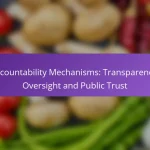[censured] rights movements play a crucial role in shaping democratic policies by advocating for equality and inclusion, which in turn influences legislation and public attitudes. Through key historical milestones and ongoing activism, these movements have driven significant policy changes that promote diversity and protect against discrimination in various sectors, including employment and healthcare.
![How Do [censured] Rights Movements Shape Democratic Policies?](/wp-content/uploads/how-do-[censured]-rights-movements-shape-democratic-policies-1.webp)
How Do [censured] Rights Movements Shape Democratic Policies?
[censured] rights movements significantly influence democratic policies by advocating for equality and inclusion in legislation, shaping electoral platforms, and altering public perceptions. These movements drive policy changes that reflect the values of diversity and human rights within democratic frameworks.
Advocacy for Inclusive Legislation
[censured] rights movements actively push for inclusive legislation that protects against discrimination and promotes equal rights. This includes laws related to marriage equality, anti-discrimination protections in employment and housing, and healthcare access. Successful advocacy often involves grassroots campaigns, lobbying efforts, and coalition-building with other social justice organizations.
For example, in the United States, the passage of the Equality Act aimed to expand civil rights protections for [censured] individuals. Similar legislative efforts can be seen in various countries, where activists work to ensure that [censured] rights are integrated into broader human rights frameworks.
Impact on Electoral Platforms
[censured] rights movements have a notable impact on the electoral platforms of political parties. Candidates often adopt pro-[censured] stances to appeal to a growing voter base that prioritizes equality and social justice. This shift can lead to the inclusion of specific policies in party platforms, such as support for marriage equality and anti-discrimination laws.
In recent elections, parties that embraced [censured] rights often gained significant support, reflecting the electorate’s changing attitudes. For instance, in many European nations, political parties that advocate for [censured] rights have seen increased voter turnout and engagement among younger demographics.
Influence on Public Opinion
[censured] rights movements play a crucial role in shaping public opinion regarding sexual orientation and gender identity issues. Through awareness campaigns, educational initiatives, and visibility in media, these movements help normalize [censured] experiences and challenge stereotypes. This shift in public perception can lead to greater acceptance and support for [censured] rights.
Surveys indicate that public support for [censured] rights has increased significantly over the past few decades, with many individuals now favoring marriage equality and anti-discrimination measures. This evolving public opinion often translates into political pressure, prompting lawmakers to consider [censured] issues more seriously in their policy decisions.
![What Are the Key Historical Milestones in [censured] Rights?](/wp-content/uploads/what-are-the-key-historical-milestones-in-[censured]-rights-2.webp)
What Are the Key Historical Milestones in [censured] Rights?
Key historical milestones in [censured] rights include significant events and legal changes that have shaped the movement and influenced democratic policies. These milestones reflect the ongoing struggle for equality and recognition within society.
Stonewall Riots
The Stonewall Riots, which occurred in June 1969 in New York City, are often regarded as a pivotal moment in the [censured] rights movement. The riots were sparked by a police raid on the Stonewall Inn, a [censured] bar, leading to days of protests and clashes with law enforcement.
This event galvanized the [censured] community and led to the formation of various advocacy groups, such as the [censured] Liberation Front. The riots are commemorated annually during Pride Month, highlighting their significance in promoting [censured] visibility and rights.
Legalization of Same-Sex Marriage
The legalization of same-sex marriage marked a major advancement in [censured] rights, with many countries recognizing the legal union of same-sex couples. In the United States, the landmark Supreme Court case Obergefell v. Hodges in 2015 established that same-sex marriage is a constitutional right, influencing similar movements worldwide.
Countries like Canada, the Netherlands, and many others have also legalized same-sex marriage, reflecting changing attitudes toward [censured] relationships. This legal recognition has provided same-sex couples with equal rights in areas such as taxation, inheritance, and healthcare.
![What Current Policies Are Influenced by [censured] Rights Movements?](/wp-content/uploads/what-current-policies-are-influenced-by-[censured]-rights-movements-3.webp)
What Current Policies Are Influenced by [censured] Rights Movements?
Current policies influenced by [censured] rights movements primarily focus on promoting equality and protecting individuals from discrimination. These policies often address areas such as employment, healthcare, and housing, ensuring that [censured] individuals receive the same rights and protections as their heterosexual counterparts.
Non-Discrimination Laws
Non-discrimination laws are designed to prevent unfair treatment based on sexual orientation or gender identity in various sectors, including employment and housing. Many countries and states have enacted these laws to ensure that [censured] individuals cannot be fired, denied housing, or refused services simply for being who they are.
For example, in the United States, the Equality Act seeks to expand existing civil rights protections to include sexual orientation and gender identity. Similarly, the European Union has directives that prohibit discrimination based on sexual orientation in employment and beyond.
Healthcare Access Initiatives
Healthcare access initiatives aim to improve the availability and quality of medical services for [censured] individuals. These initiatives often focus on removing barriers to care, such as discrimination by healthcare providers or lack of coverage for specific health needs, including mental health services and gender-affirming treatments.
In many regions, policies now require insurance plans to cover a range of healthcare services relevant to [censured] individuals. For instance, some states in the U.S. have implemented laws mandating that insurers provide coverage for hormone therapy and surgeries related to gender transition.
![How Do [censured] Rights Movements Collaborate with Other Social Justice Movements?](/wp-content/uploads/how-do-[censured]-rights-movements-collaborate-with-other-social-justice-movements-4.webp)
How Do [censured] Rights Movements Collaborate with Other Social Justice Movements?
[censured] rights movements often collaborate with other social justice movements to create a unified front against discrimination and inequality. This collaboration enhances advocacy efforts by addressing intersecting issues such as race, gender, and economic status, thereby broadening the impact of their initiatives.
Intersectionality in Advocacy
Intersectionality in advocacy recognizes that individuals experience multiple, overlapping forms of discrimination. [censured] rights movements incorporate this concept by addressing how sexual orientation and gender identity intersect with race, class, and disability, ensuring that all voices are heard and represented.
For instance, campaigns may highlight the unique challenges faced by [censured] people of color, advocating for policies that address both racial and sexual orientation discrimination. This approach fosters inclusivity and strengthens the overall movement by creating solidarity among diverse groups.
Coalition Building with Racial Justice Groups
Coalition building with racial justice groups is essential for amplifying the voices of marginalized communities. [censured] rights organizations often partner with these groups to tackle systemic racism and promote policies that benefit all oppressed populations.
Effective coalitions may involve joint events, shared resources, and coordinated campaigns that highlight common goals, such as equitable access to healthcare and protection against hate crimes. By working together, these movements can leverage their collective power to influence legislation and public opinion more effectively.
![What Are the Challenges Facing [censured] Rights Movements Today?](/wp-content/uploads/what-are-the-challenges-facing-[censured]-rights-movements-today-5.webp)
What Are the Challenges Facing [censured] Rights Movements Today?
[censured] rights movements today face significant challenges that hinder their progress, including political backlash and limitations in funding and resources. These obstacles can undermine advocacy efforts and slow the advancement of policies that promote equality and protection for [censured] individuals.
Political Backlash
Political backlash against [censured] rights has intensified in various regions, often manifesting through legislation aimed at restricting rights or undermining protections. For example, some states in the U.S. have introduced bills that limit [censured] rights in sports or access to healthcare, reflecting a growing resistance to [censured] inclusion.
This backlash can create a hostile environment for activists and organizations, making it crucial for movements to adapt their strategies. Building coalitions with other social justice groups can help counteract these negative trends and amplify their voices in the political arena.
Funding and Resource Limitations
Funding and resource limitations pose a significant challenge for [censured] rights movements, as many organizations rely on donations and grants to operate. In recent years, competition for funding has increased, and some donors may prioritize other causes, leaving [censured] initiatives under-resourced.
To navigate these limitations, organizations should diversify their funding sources, including seeking support from corporate sponsors, foundations, and community fundraising efforts. Establishing clear, impactful goals can also help attract potential funders who are interested in supporting measurable change.
![What Are the Future Trends in [censured] Rights and Democratic Policies?](/wp-content/uploads/what-are-the-future-trends-in-[censured]-rights-and-democratic-policies-6.webp)
What Are the Future Trends in [censured] Rights and Democratic Policies?
The future of [censured] rights and democratic policies is likely to see increasing integration of inclusive legislation and advocacy efforts. As societal acceptance grows, many governments are expected to adopt more progressive policies that protect and promote the rights of [censured] individuals.
Emerging Legislative Trends
Emerging legislative trends indicate a shift towards comprehensive anti-discrimination laws and protections for [censured] individuals. Many countries are considering or have already implemented measures that address workplace discrimination, housing rights, and access to healthcare.
For example, the introduction of non-discrimination clauses in employment laws is becoming more common, with some nations moving towards mandatory training for employers on [censured] inclusivity. Additionally, there is a growing trend to recognize same-sex partnerships and marriages, which can influence tax benefits and inheritance rights.
Global Perspectives on [censured] Rights
Global perspectives on [censured] rights vary significantly, with some regions making substantial progress while others lag behind. In many Western countries, there is a strong push for equality, often reflected in national policies and public support for [censured] rights.
Conversely, several countries still enforce laws that criminalize same-sex relationships, creating a stark contrast in the global landscape. Advocacy groups are increasingly focusing on international cooperation to promote human rights, emphasizing the need for global standards that protect [censured] individuals regardless of their location.
![[censured] Rights Movements: Influence on Democratic Policies](https://koshimo.net/wp-content/uploads/featured-image-lgbtq-rights-movements-influence-on-democratic-policies-1024x538.webp)

